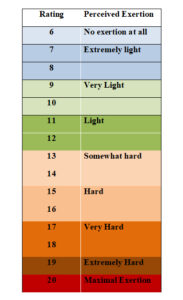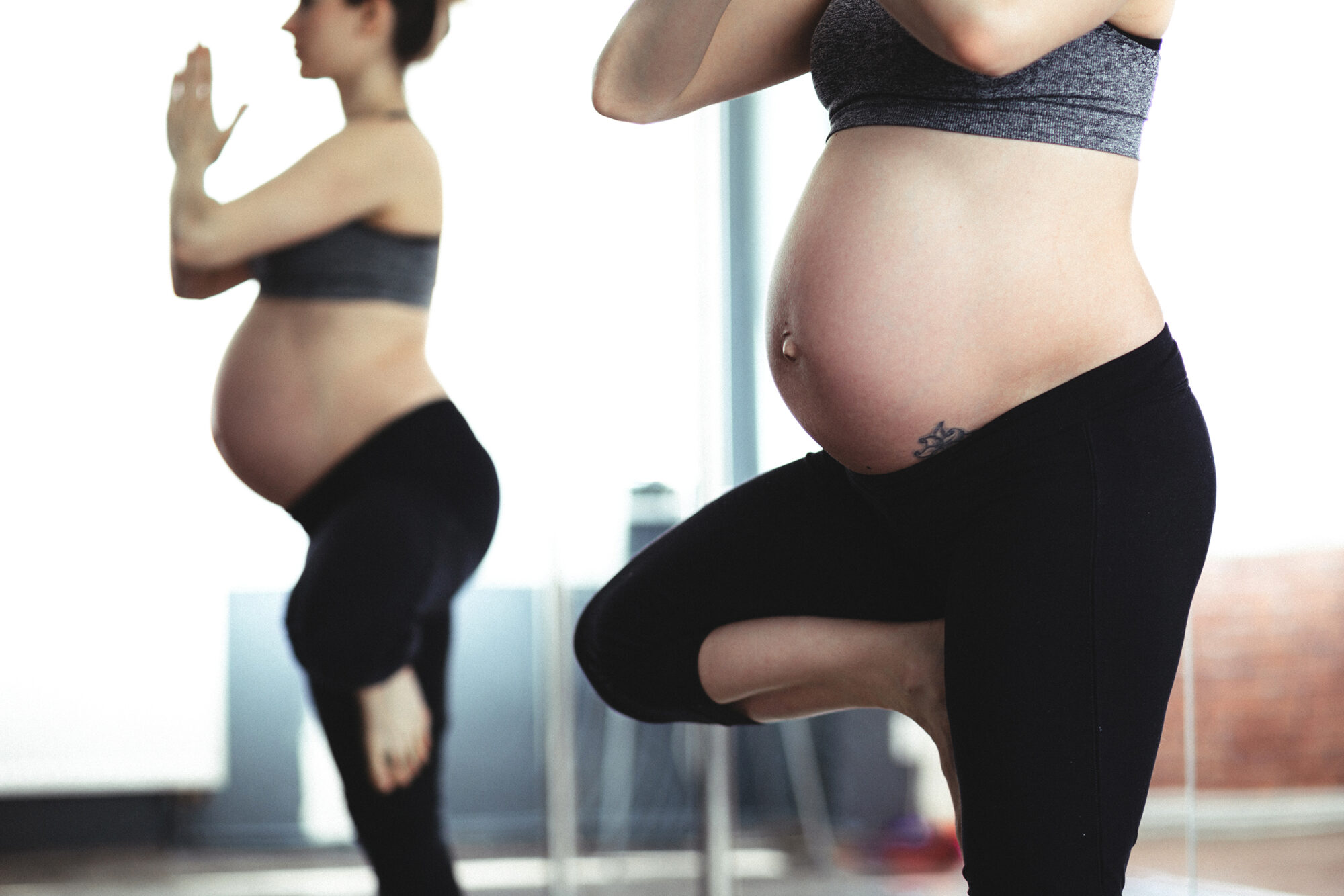By Motion Physical Therapist: Dr. Alyssa George, PT, DPT, OCS
According to the American College of Obstetrics and Gynecology, participation in a wide range of recreational activities appears to be safe during pregnancy, but each sport should be reviewed for its potential risk. Activities with a high risk of falling or with a high risk of abdominal trauma should be avoided during pregnancy. In the absence of medical or obstetric complications, pregnant women should be encouraged to engage in regular, moderate intensity physical activity during pregnancy. (6)
Benefits of Exercise During Pregnancy
30 minutes on most to all days of the week
- Reduce backaches, constipation, bloating, swelling
- Increase energy
- Help prevent or treat gestational diabetes
- Improve mood
- Improve posture
- Promote muscle tone, strength, endurance
- Improve sleep
Safe Forms of Exercise
- Walking
- Swimming
- Cycling
- Aerobics
- Running (if already a runner)
Forms of Exercise to Avoid
- Activities with high risk of falls (gymnastics, water skiing, horseback riding)
- Downhill snow skiing- increased risk of falls
- Contact sports
- Scuba diving- baby at risk of decompression sickness
- Exertion at altitudes above 6,000 feet
- Exercise in extreme temperatures
Signs to STOP Exercising
- Vaginal bleeding
- Dizziness or feeling faint
- Increased shortness of breath
- Chest pain
- Headache
- Muscle weakness
- Calf pain or swelling
- Uterine contractions
- Decreased fetal movement
- Fluid leaking from vagina
Precautions When Exercising During Pregnancy
- Avoid exercising flat on your back after 3 months of your pregnancy
- Avoid standing for long periods of time
- Stop exercising when you are tired. Do not exercise until you feel exhausted
- Avoid any type of exercises that can cause even mild trauma to the abdomen
- Changes that occur in the body shape and size over pregnancy will limit the types of exercise you can do safely as your balance changes.
Avoid Exercise During Pregnancy if the Following are Present
(Absolute Contraindications)
- Hemodynamically significant heart disease
- Restrictive lung disease
- Incompetent cervix/ cerclage
- Multiple gestation (i.e. multiple births in one delivery-twins) at risk for premature labor
- Persistent second- or third-trimester bleeding
- Placenta previa after 26 weeks of gestation
- Premature labor during the current pregnancy
- Ruptured membranes
- Preeclampsia/ pregnancy- induced hypertension
Caution Should be Used with Exercise During Pregnancy if the Following are Present
(Relative Contraindications)
- Severe anemia
- Unevaluated maternal cardiac arrhythmia
- Chronic bronchitis
- Poorly controlled type I diabetes
- Extreme morbid obesity
- Extreme underweight (BMI <12)
- History of extremely sedentary lifestyle
- Intrauterine growth restriction in current pregnancy
- Poorly controlled hypertension
- Orthopedic limitations
- Poorly controlled seizure disorder
- Poorly controlled hyperthyroidism
- Heavy smoker
Exertion
Pregnant women should follow the rating of perceived exertion scale to measure effort during exercise. This scale ranks effort from 6 to 20. Moderate intensity/ effort is advised during pregnancy, which is a rating of 12-14 on this scale. 
Exercise- Strength Training
Safety Guidelines for Strength Training During Pregnancy (7)
- Use lighter weights and more repetitions. Heavy weights may overload already lax joints that are loosened by increased levels of the hormone relaxin during pregnancy. For example, if you typically perform the leg press with 35 lbs. for 8-12 repetitions, try 20 lbs. for 15-20 repetitions.
- Try avoiding walking lunges. This may increase the risk of injury to the pelvic area and further stress joints if you have pelvic, SI, or pubic symphysis pain.
- Use caution with free weights due to risk of hitting the abdomen. Resistance bands are a good alternative.
- Try not to lift while flat on your back during the second and third trimesters. Lying on your back can cause the uterus to compress a blood vessel called the inferior vena cava.
- Avoid the Valsalva maneuver. This maneuver is forcefully exhaling without releasing air. This can cause an increase in blood and intra-abdominal pressures and may decrease oxygen flow to the fetus. This can also put excess pressure on the pelvic floor.
Exercise Prescription during Pregnancy (8)
- Frequency: 3 days/week, nonconsecutive days
- Intensity: < 70% of your 1 Repetition Max; 10 reps or more per set
- Type: Large muscle groups
- Suggested 1 exercise per muscle group
- Beginners: 1 set per exercise; 2-3 sets for advanced patients; rest 2 minutes between sets
Upper Body Exercises
*Sample for first trimester
- Shoulder Press
- Biceps Curl
- Lateral raise
- Triceps kickback
- Rows
Lower Body Exercises
*Sample for first Trimester
- Lunge *Avoid if experiencing pelvic/ SI joint dysfunction
- Squats
- Standing Calf raise
- Side lying abduction
- Adduction Squeezes
Core Exercises
Plank: Starting on your hands and knees, feet together, spine in neutral position. Lift body up on forearms and toes, keeping your body as straight as possible. Maintain for 30-60 seconds while breathing. These can be modified to increase or decrease difficulty depending on your current level of strength/fitness.
Bird Dog: Begin on hands and knees, spine in neutral. Simultaneously extend right leg and left arm so they are parallel to the floor. Hold for 5-10 breaths then repeat with the other arm/leg combination.
Side Plank: Lie on right side, legs straight, right palm on floor, left foot stacked on top of the right. Straighten your right arm or come to right forearm. Hold 5-10 breaths then repeat with the opposite side.
Exercises- Stretching
Upper Body Stretches
Full Body Stretch
This exercise helps you warm up by stretching your whole body.
- Lie on you back or stand.
- Straighten out your arms and legs
- Point your toes and stretch out your fingers.
- Then pull toes up toward your knees. Hold for 5 seconds then relax.
Side Body Stretch
This exercise helps to stretch the side of the body.
- Sit in a comfortable position.
- Stretch one arm up overhead and lean to the opposite side.
- You should feel a stretch in that side of the body.
- Hold 15-30 seconds.
Forward Fold Stretch
- Stand facing a wall or chair
- Lean forward with back straight, and continue to lean forward until you can feel a stretch through your back and hamstrings.
- Hold for 10-15 seconds.
**Be sure to hold on to a supportive surface if balance is compromised in this position.
Neck Stretches
Position 1
- Sit on the floor with your ankles crossed.
- Look down and place your hand on the back of your neck.
- Gently push down until you feel a stretch in the back of your neck.
- Hold 10 seconds. Repeat 3-5 times.
Position 2
- While sitting on the floor with ankles crossed, turn your head to the right.
- Repeat to the left.
- Repeat slowly on each side.
- Hold 10 seconds. Repeat 3-5
Position 3
- While sitting, put your right hand on top of your head.
- Pull your head gently so that your right ear gets closer to your shoulder.
- Switch sides and repeat 3-5 times.
Full Body Twist
This exercise will stretch your waist, upper body and neck. It helps to keep your spine more flexible.
- Sit on floor with legs bent at knees and crossed in front of you or seated in chair.
- Place your left hand on your right knee and twist to your right.
- Put your right palm on the floor behind you next to your spine with your elbow straight.
- Inhale slowly, then exhale.
- Switch and twist to the left.
- Repeat 3-5 times each side.
Cat/Cow Stretch
Stretches the back.
Begin on hands and knees. Gently move the center of your back down while bringing head up (arch your back) and back up with head down (round your back). Repeat 10 times.
Child’s Pose
Stretches the back.
Start on your hands and knees, press hips back towards your heels, reaching forearms forward on floor. Forehead rests on forearms. Hold 3-5 breaths.
Lower Body Stretches
Butterfly Stretch
This exercise stretches inner thighs.
- Sit upright with knees bent and feet together
- Draw feet closer to body until they are placed close to the groin.
- Sit straight up.
- Maintain position for 10-15 seconds.
Hamstring Stretch
- Lie on your back with your feet flat on the floor. Press the small of your back into the floor.
- Bring one knee, as close as you can, to your chest.
- Straighten that leg, bringing foot towards the ceiling.
- Bend your knee and return your foot to the floor.
- Do the same exercise with the other leg.
- Hold for 15-30 seconds.
Figure Four Stretch
- In a seated position, place left ankle over right knee.
- While keeping the back straight, lean forward over legs.
- Lean forward until you feel a stretch in the left buttock.
- Stretch into tension but not pain
- Hold for 15-30 seconds.
Round Ligament Stretch
- Sit comfortably in a chair with legs wider than hip width apart and feet pointed forward or slightly out to the sides.
- Keep the back straight as you lean forward to bring belly between legs.
- Rest elbows on thighs and lean as far forward between the legs as is comfortable.
- This stretch should not be painful but you should feel a stretch above the pubic bone.
- Hold this position for 15-30 seconds.
Dr. Alyssa George, PT, DPT, OCS

Alyssa wants to get you back to doing what you love, whether that be sports/recreational activities, your career, or caring for your family. Specializing in treating pelvic and orthopedic conditions, Alyssa develops individualized treatment plans because she understands that no two bodies are alike. She has been involved in research projects to help advance the field of physical therapy. Most recently she has written a case series detailing the benefits of dry needling for chronic pelvic pain and presented on the function of breathing muscles in pelvic pain at the American Physical Therapy Association’s Combined Sections Meeting. She has over nine years of experience as a physical therapist and has started and led pelvic health programs at clinics in Texas, Ohio, and now Minnesota, her home state.
Alyssa earned a Bachelor of Arts degree in biology from Gustavus Adolphus College, a Master of Physical Therapy degree from the University of Wisconsin-Madison, and continued her education at the University of Montana, earning her Doctorate in Physical Therapy. She is a board-certified clinical specialist in orthopedics and earned her certification in pelvic physical therapy from the American Physical Therapy Association Section on Women’s Health. She has been a lecturer and faculty mentor of both orthopedic residency and manual therapy fellowship programs at The Ohio State University and is a credentialed clinical instructor for physical therapy students. Alyssa has been certified in dry needling and utilizes other various manual therapy techniques in her management of abdominopelvic disorders (including incontinence, constipation, lumbopelvic pain, and pregnancy-related musculoskeletal disorders) and orthopedic conditions of the neck, back, shoulder, hip, knee, and foot/ankle.
Schedule an Appointment with Dr. Alyssa Today for a More In-Depth Assessment



